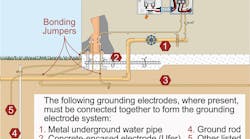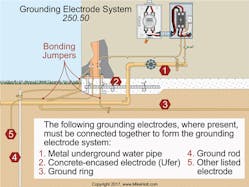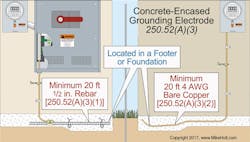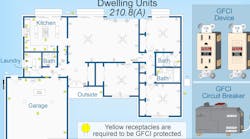One common NEC violation is an installation where grounding electrodes aren’t bonded together. All grounding electrodes present at a building must be bonded together to form the grounding electrode system (Fig. 1).
Have you seen this rule violated? Have you violated it yourself? And what kinds of items are considered grounding electrodes?
Electrode types
Each of the following can serve as a grounding electrode [250.52]:
• Metal underground water pipe in direct contact with the earth for 10 ft or more [250.52(A)(1)].
• Metal in-ground support structure(s) in direct contact with the earth vertically for 10 ft or more [250.52(A)(2)].
• Concrete-encased electrode that is either one or more electrically conductive steel reinforcing bars of at least ½ in. diameter, mechanically connected together by steel tie wires (or other effective means) to create a 20 ft or greater length [250.52(A)(3)(1)] or a bare copper conductor not smaller than 4 AWG and at least 20 ft long [250.52(A)(3)(2)] (Fig. 2).
• Ground ring consisting of at least 20 ft of bare copper conductor not smaller than 2 AWG buried in the earth encircling a building [250.52(A)(4)].
• Rod electrode with at least 8 ft in length in contact with the earth [250.53(G)] and diameter of at least 5⁄8 in., unless listed [250.52(A)(5)].
• Other listed grounding electrodes [250.52(A)(6)].
• Bare or electrically conductive coated iron or steel plate at least ¼ in. thick, or a solid uncoated copper metal plate at least 0.06 in. thick, with an exposed surface area of at least 2 sq ft [250.52(A)(7)].
• Metal underground systems, piping, and well casings [250.52(A)(8)].
You can’t use any of these as a grounding electrode:
• Underground metal gas-piping systems [250.52(B)(1)].
• Aluminum [250.52(B)(2)].
• Swimming pool reinforcing steel [250.52(B)(3)]
The 2017 Code changes to Sec. 250.52 clarified that structural metal is allowed to be an electrode. It added a requirement prohibiting the use of swimming pool steel as an electrode.
Related
The structural metal is now called “metal in-ground support structure(s).” The metal of a building isn’t a grounding electrode unless it’s actually in the earth for 10 vertical feet — hence the name “metal in-ground support structure(s).”
Structural metal that isn’t an electrode (because it isn’t in the earth for 10 ft) can still be used to interconnect electrodes [250.68(C)(2)].
Electrode installation requirements
The 2017 NEC revised the installation requirements for ground ring electrodes, for consistency with other rules. Instead of “burying” a ground ring, we now “install” it.
Some highlights of Sec. 250.53 to be aware of include:
• If practicable, pipe electrodes must be embedded below the permanent moisture level and be free from nonconductive coatings (e.g., paint or enamel) [250.53(A)(1)].
• A rod electrode must be supplemented by an additional electrode that’s bonded to the service disconnect or one of the other four items listed in Sec. 250.53(A)(2).
• The supplemental electrode for a rod electrode must be installed at least 6 ft from the rod electrode [250.53(A)(3)].
• Electrodes for premises systems must be at least 6 ft from lightning protection system grounding electrodes [250.53(B)].
• Two or more grounding electrodes bonded together are considered a single grounding electrode system.
• The bonding connection for the interior metal water piping system, as required by Sec. 250.104(A), can’t depend on equipment likely to be disconnected for repairs or replacement. Install a bonding jumper around insulated joints and equipment likely to be disconnected for repairs or replacement [250.53(D)] (Fig. 3).
• When an underground metal water pipe grounding electrode is present, it must be used as part of the grounding electrode system [250.52(A)(1)].
• Rod electrodes must be installed with at least 8 ft of length in contact with the soil. If rock bottom is encountered, then the rod must be driven at an angle not to exceed 45° from vertical [250.53(G)].
Lightning protection electrode. The 2017 NEC revised the two Informational Notes regarding lightning protection electrodes [250.60]:
• Informational Note 1 revision directs us to Sec. 250.106, which has other Informational Notes regarding additional rules for lightning protection equipment, not just strike termination devices (formerly known as “air terminals” or “lightning rods”).
• Informational Note 2 revision clarifies that it’s talking about voltage differences.
A lightning protection system installed per NFPA 780, Standard for the Installation of Lightning Protection Systems, is intended to protect the structure from lightning damage. You can’t use the lightning protection electrode for the building (or structure) grounding electrode system required for service equipment [250.24] and remote building feeder disconnecting means [250.32(A)]. Electrodes that are part of a lightning protection system must be bonded to the building grounding electrode system [250.106].
Grounding electrode conductor installation
Grounding electrode conductors (GECs) must be installed as specified in Sec. 250.64(A) through (F). In this Code cycle, the Code Making Panels made an effort throughout the NEC to improve its usability. Therefore, these requirements were reorganized into a list so they’re easier to read and understand.
It’s a fairly long list that we don’t need to restate here. But one key requirement is GECs sized 8 AWG must be protected by installing them in rigid metal conduit (RMC), intermediate metal conduit (IMC), PVC conduit, electrical metallic tubing (EMT), Type XW reinforced thermosetting resin conduit (RTRC-XW), or cable armor [250.64(B)(3)].
A ferrous metal raceway containing a GEC must be made electrically continuous by bonding each end of it to the GEC [250.64(E)].
Also, remember that this is grounding (connecting to the earth, see Art. 100 definition). That means grounding electrodes are for supply-side, not load-side, equipment. A GEC can be connected from an accessible enclosure on the supply side of the disconnect to one or more of the following locations [250.64(D)(3)]:
1) The service neutral conductor.
2) The equipment grounding conductor (EGC) of the feeder circuit.
3) The supply-side bonding jumper.
Grounding electrode conductor size
The rules in Sec. 250.66(A), (B), and (C) (which many people don’t read) allow for smaller GECs for driven rods, concrete-encased electrodes, and ground rings than those in Table 250.66. Previous to the 2017 Edition of the Code, you could use these smaller GECs only when the GEC is the “sole connection” to these electrodes.
What exactly does “sole connection” mean? We won’t be asking this question any longer, because that language was replaced. You can use the smaller GECs if they don’t also connect to an electrode requiring a larger GEC.
Grounding electrode termination
The 2017 NEC clarifies requirements for a GEC connection to [250.68(C)]:
• A metal underground water pipe.
• Building steel that’s a GEC.
• Rebar electrodes that extend vertically through a slab.
For quite some time, we’ve had to connect to the underground metal piping system as part of grounding the electrical equipment. Because of the concern over interior metal piping being replaced with nonmetallic piping, the Code has required making the grounding electrode connection within 5 ft of where the metal underground water pipe enters the building. This rule was accidentally changed to permissive language during some of the (rather extensive) editing of this section previously. The issue is resolved now by making it mandatory text once again.
The structural metal of a building isn’t always a grounding electrode. In fact, it seldom is. But we can use it as a conductor to interconnect electrodes, and it makes a great one with all of the cross-sectional area that it has. If we connect the structural metal to a concrete-encased electrode, it doesn’t magically become an electrode (it still doesn’t have 10 ft of steel vertically in the earth). But it can now be used to connect, for example, the underground water pipe to the concrete-encased electrode. You can connect the concrete-encased electrode to the metal by connecting the bolts in the footings to the rebar (concrete-encased electrode) in the footings.
The practice of continuing a piece of rebar vertically through the top of a foundation wall and connecting a GEC has been done for decades, and it’s proven effective. In the 2014 Edition of the Code, it was made clear this practice is acceptable. In 2017, it’s being made clear this practice is permitted only if the exposed rebar is not subject to corrosion and if it does not make contact with the earth.
These materials are provided to us by Mike Holt Enterprises in Leesburg, Fla. To view Code training materials offered by this company, visit www.mikeholt.com/code








